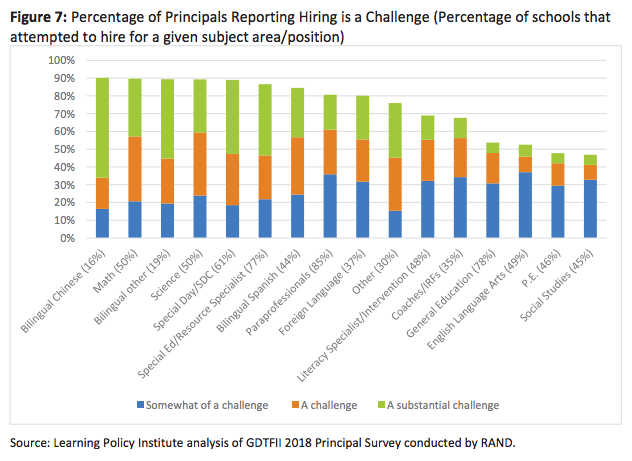
It is often said that half of new teachers quit within five years. Like all good myths, it contains a kernel of truth.
In This Lesson

What is teacher retention?
Why do teachers leave?
What is teacher turnover?
What is teacher burnout?
Do most teachers really quit within five years?
What is a teacher shortage?
What makes teachers want to stay?
Is teacher retention important?
How can we get teachers to stay at our school?
▶ Watch the video summary
★ Discussion Guide.
This lesson explores what leads some teachers to stay in the classroom, what motivates others to move on, why it matters, and what schools do to retain teachers they want to keep. It also explores the corrosive effect of partisan politics on the teaching profession.
The five-year teacher myth
Let's start with the myth, because it's interesting on a lot of levels. As we explored in Lesson 3.2, people don't just get teaching jobs on a whim. They go through years of college, then pay hundreds of dollars to endure a hazing ritual of certification tests that most find disappointingly easy. They make personal sacrifices to choose a career that they know from the start doesn't pay very well. After all that effort, is it true that half of them really walk away, even chucking the pension they will receive only if they stick it out at least for a fifth year?
The short answer is no, of course not. Most who start teaching stay with it well beyond five years. But the longer answer is that the quitting rate varies. Teachers are more likely to quit if they are working in difficult conditions and if they are unprepared for it.
For years, the "half quit" myth persisted not just because it was quotable — it was surprisingly hard to disprove. Education data systems were (and still are) pretty awful, even when it comes to the simple job of counting noses. Teachers tend to change jobs within schools, take leaves, change schools, and change their names. School systems don't necessarily connect to one another. With repetition, an incorrect estimate mutated into conventional wisdom.
Do half of new teachers depart the profession within five years? No, that's a myth. It's closer to a quarter.
The National Center for Education Statistics (NCES) tried to set the record straight in 2015 with a longitudinal survey that found at least 82.7% of those who started as teachers in 2007 were still teaching or serving in other education roles five years later. Other studies, using different methods, concluded that this estimate might be too rosy, pegging the average five-year teacher retention rate at about 70%. There's room for interpretation, but either way: myth busted. It's definitely less than half.
But the point isn't purely wrong. In today’s developed nations, most people are career-changers, and this includes teachers. Teacher turnover is a big challenge for California schools, especially in high-need areas like special education and bilingual education. During the pandemic, teachers quit in unprecedented numbers. It will take time to sort out the new normal.
Why do teachers leave?
Most of the reasons why teachers leave a school are not unique to teaching. The big drivers are personal needs, like the birth of a child or a spouse's work. Teachers leave their jobs at rates that vary widely among schools, with high-poverty schools generally experiencing the highest turnover rates. Teaching can be lonely work, and nobody likes to feel unsupported. Factors like poor working conditions and lack of administrative support can feel like a form of disrespect.
Partisan divides are reducing public education from a universal priority to an "issue area"
The eroding social standing of the teaching profession has become a growing factor in teacher retention. For generations, public education was a bipartisan priority. Teachers, like physicians, were widely perceived as working beyond the realm of politics. In 2023, a set of studies by Pew Research confirmed that those days are over: education has become another brick in the partisan wall that divides America.
Why don't teachers leave?
Teaching matters to kids, families, communities, and the world. People who choose a teaching career are only half-joking when they say they are paid in the form of psychic benefits or good karma.
In the private sector, it's normal to change employers every so often, even expected. In teaching, by contrast, the incentives are different. As explained in Ed100 Lesson 3.8, the pay system for teachers is strongly based on seniority Teachers who move from one district to another generally lose their seniority and can face a pay cut. Less obviously, the financial hit of a pay cut is multiplied by the teacher pension system, which is the subject of Lesson 3.11.
Why does teacher retention matter?
It takes a few years to learn any new job and get good at it. Over time, teachers develop ways to collaborate. Turnover disrupts those patterns. Recruiting and on-boarding of faculty is costly. Students in poverty are more likely than other students to attend schools with high teacher turnover and less-experienced educators.

Great school leaders work very hard to retain their best teachers because their impact is massive. In a study involving 2.5 million students and 18 million test scores, researcher Raj Chetty and colleagues demonstrated that a teacher whose students consistently perform better than predicted based on past measures, can have a large, long-lasting effect on students' success in school.
Teacher shortages
As described in Lesson 3.2, the labor market for teachers drastically changes depending on whether the economy (and thus tax revenue) is growing or shrinking. When budgets are very tight, school districts often can't afford all of their teachers. The newest ones, with the least seniority in their district, check their mailboxes for warnings that they may not have a job. (These notices are commonly called pink slips.) When budgets are growing, by contrast, school districts may experience a teacher shortage, meaning that there are not enough candidates with the right credentials to fill open positions. Teachers with seniority may take advantage of the moment to negotiate a shift to a school they like better. School districts fill the gaps with whoever they can get.
These on-again, off-again cycles in the labor market for teaching have become part of the expectations for new teacher candidates. Teaching is a deeply meaningful job, but until you gain seniority it can't be assumed to be a safe one. (We take up this topic further in Lesson 3.10)
Staffing has become challenging throughout California schools in recent years, especially for schools in rural and disadvantaged areas. Bilingual teachers and special education teachers are in particular demand.

Teacher induction programs and strategies
Some school districts help new teachers learn the ropes by investing in training and mentorship programs. In education lingo, this kind of on-the-job support is known as an induction program. If they are well-implemented, induction programs not only reduce the density of "rookies" in schools, they also save money that would otherwise be spent recruiting and hiring new teachers. California has made induction programs the preferred way for a teacher to complete requirements for a clear or professional credential. Some teacher induction programs are better than others, though. In order to raise the level of quality of such programs, California has established standards for them.
Successful teacher induction programs save money.
Some of the state's larger districts take a “grow your own” approach to teacher recruitment and education. Many of these local programs aim to cultivate and support teachers with a deep commitment to a community. For example, the City College Teacher Prep Center of San Francisco provides information, resources, and advice for students interested in teaching as a career. This includes assistance with university transfer for advanced degrees as well as support to obtain elementary, secondary, and career technical education (CTE) credentials. (Hear Carol's interview with Kathleen White about it on KALW.)
Nationwide, school districts are chronically short of teachers with the proper credentials to teach students with special education needs. To fill openings, many districts offer extra pay for these positions. According to an October 2019 study by the Education Commission of the States (ECS), “Twenty-nine states require or explicitly encourage additional pay for teachers who work in underserved schools and.or shortage subject areas.” ECS followed up with a fifty-state survey in 2022.
What is teacher burnout?
Burnout is the feeling that no matter how hard you work, nothing you can do will make a difference. Teaching is demanding work. When a school environment is effective and teachers feel like they are pulling in the same direction, it can be exhilarating. But when teachers feel unsupported, it can be physically and emotionally exhausting.
School communities sometimes try to address teacher burnout by signaling their appreciation, for example with celebrations or messages of support. These actions can be helpful, but often don't address core issues. The demands of teaching are bottomless. There is always more you could do to support students. To address teacher burnout at a fundamental level, sometimes the highest-impact investment a school system can make is training and support for school leaders. Nobody likes working for a bad boss.
Some turnover is good, right?
When great teachers leave, kids lose, especially students of color and low-income students. Reducing turnover for its own sake, however, is not the point. Some teachers are more effective than others. When school districts have to lay off teachers, what happens then? This topic is central to Ed100 lesson 3.10, Tenure and Seniority.
Our next lesson, however, turns to a simpler matter: who teaches where? How are teachers placed in classrooms?
Last updated July 2025.
CHAPTER 3:
Teachers
-
Teachers
Overview of Chapter 3 -
Teacher Recruitment
Who Teaches, and Why? -
Teacher Certification
How Are Teachers Prepared? -
Teacher Retention
How to Keep a Teacher -
Teacher Placement
Who Teaches Where? -
Teacher Development
How Do Teachers Improve? -
Teacher Collaboration
How do Educators Work Together? -
Teacher Benefits
Healthcare and Sick Days -
Teacher Pay
How much are teachers paid? -
Teacher Evaluation
How Do Teachers Know If They Are Succeeding? -
Tenure and Seniority
Teacher Tenure - Good? Evil? -
Pensions
How Good is a Teacher's Pension?
Related
Sharing is caring!
Password Reset
Search all lesson and blog content here.
Login with Email
We will send your Login Link to your email
address. Click on the link and you will be
logged into Ed100. No more passwords to
remember!














Questions & Comments
To comment or reply, please sign in .
Carol Kocivar December 30, 2024 at 1:47 pm
"High teacher turnover undermines student achievement, and larger districts can, on average, spend nearly $25,000 on replacing a departing teacher. Turnover is one of the key causes of teacher shortages because most open positions are created by teachers leaving the profession before retirement."
"LPI’s interactive tool allows policymakers and practitioners to estimate the financial cost of teacher turnover in their school, district, or state. "
https://learningpolicyinstitute.org/product/2024-whats-cost-teacher-turnover?utm_source=LPI+Master+List&utm_campaign=26d4915357-LPIMC_SeptemberUpdateTurnoverCalc_2024_09_25&utm_medium=email&utm_term=0_-26d4915357-%5BLIST_EMAIL_ID%5D
Carol Kocivar December 29, 2024 at 5:29 pm
Teachers Value Counselors, Nurses, and Special-Education Specialists More Than Pay
https://www.educationnext.org/whats-special-education-aide-worth-9607-dollar-raise-average-teacher/
Carol Kocivar December 28, 2024 at 4:46 pm
State policies impact both teaching conditions and equitable student access to well-qualified teachers. What policy approaches influence teacher supply, demand, and retention, and what can your state consider to better support teachers and students? Watch video recording
https://learningpolicyinstitute.org/event/webinar-building-and-retaining-teacher-workforce
Jeff Camp - Founder April 20, 2024 at 7:38 pm
Carol Kocivar January 9, 2023 at 4:05 pm
Carol Kocivar May 15, 2022 at 3:01 pm
https://www.nctq.org/blog/Strategies-to-build-a-sustainable-special-education-teacher-workforce
Jeff Camp - Founder January 3, 2022 at 4:35 pm
erin phelps July 18, 2021 at 10:10 am
Jenny Greene July 3, 2020 at 8:15 am
Susannah Baxendale January 14, 2019 at 10:55 am
Carol Kocivar January 29, 2016 at 2:43 pm
Teacher Residencies: http://learningpolicyinstitute.org/wp-content/uploads/2016/01/LPI-Brief-TeacherResidencies.pdf
A Case Study: Residencies at Work: http://learningpolicyinstitute.org/wp-content/uploads/2016/01/LPI-Brief-CA_TeacherResidencies.pdf
Lori M. April 22, 2015 at 6:31 pm
Janet L. April 19, 2015 at 5:03 pm
Stacey W April 6, 2015 at 6:25 pm